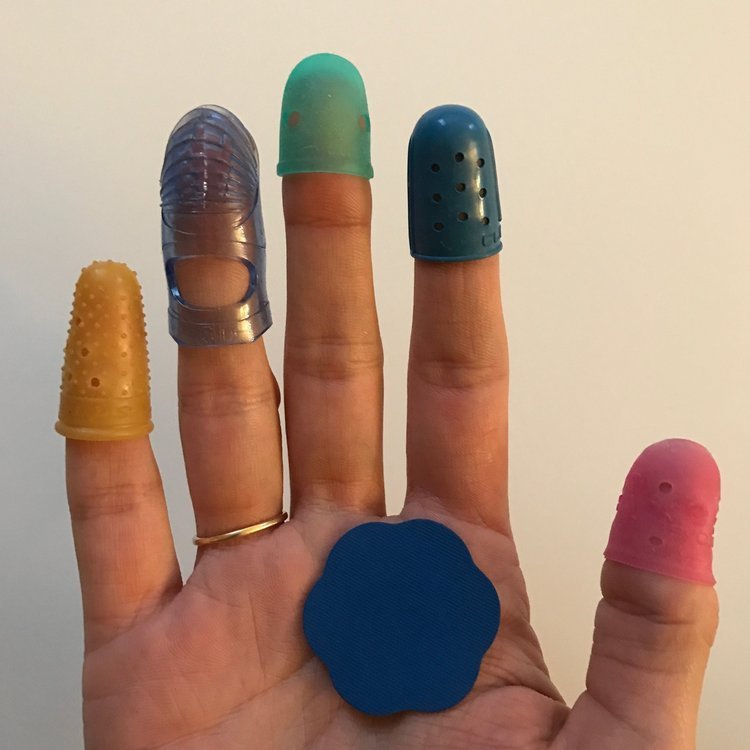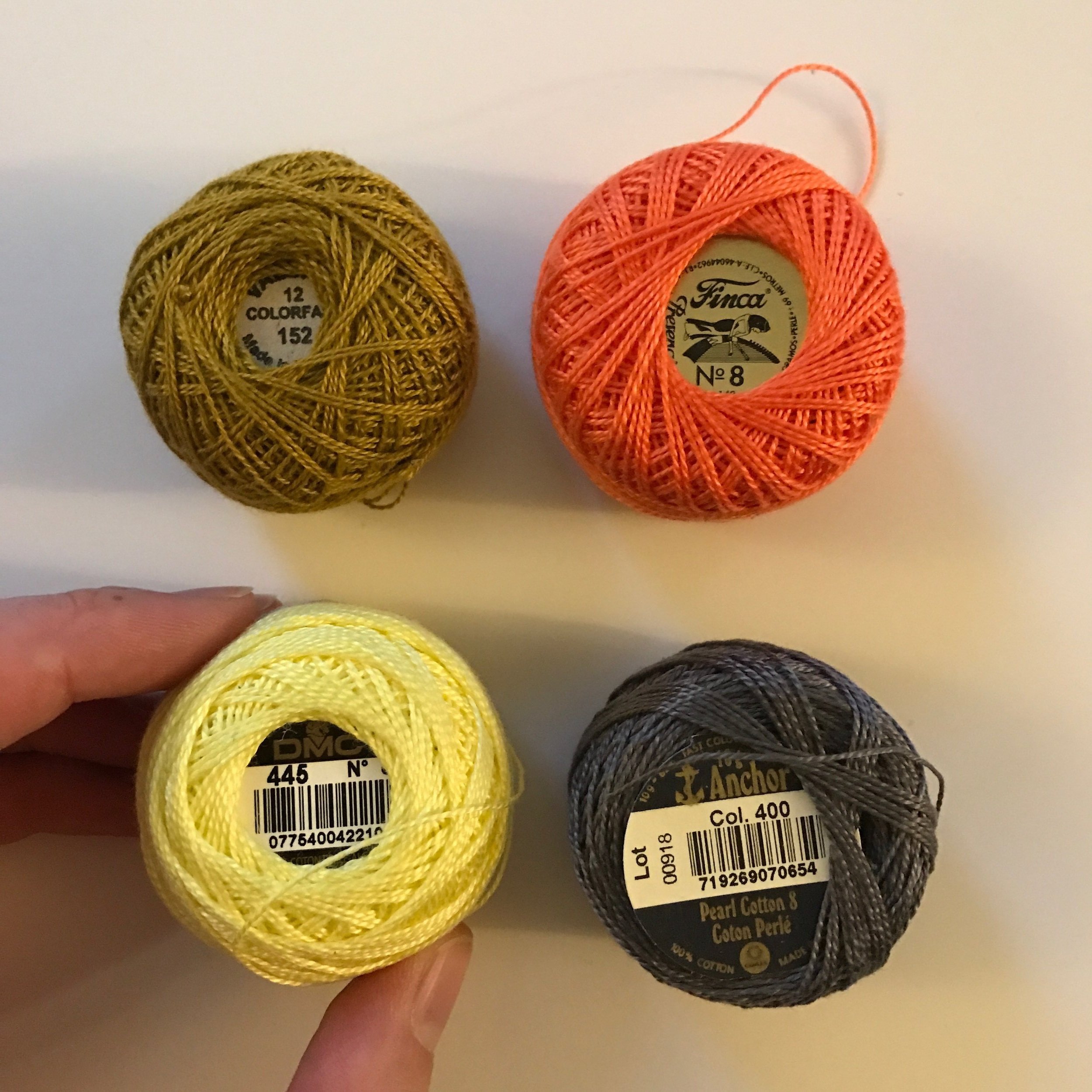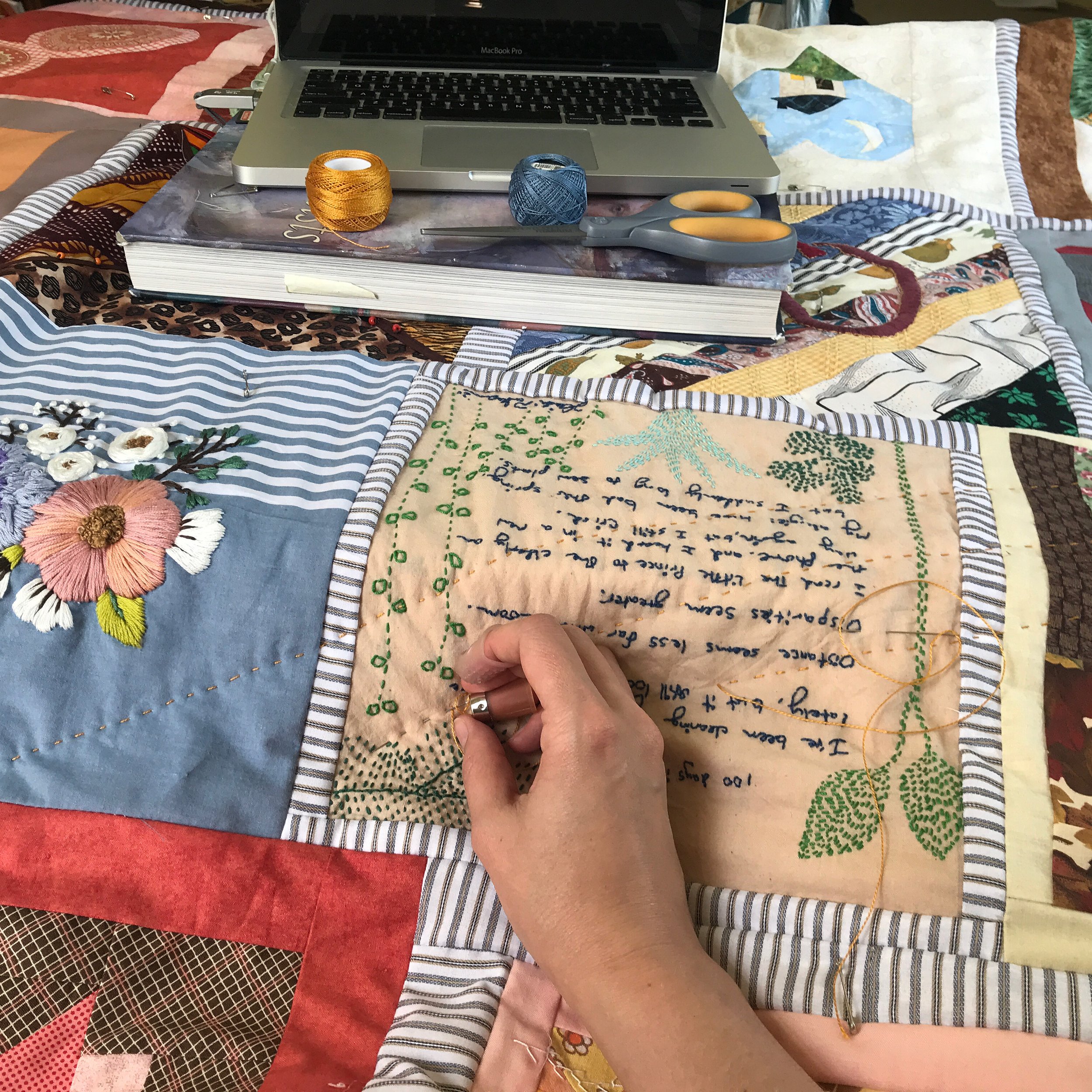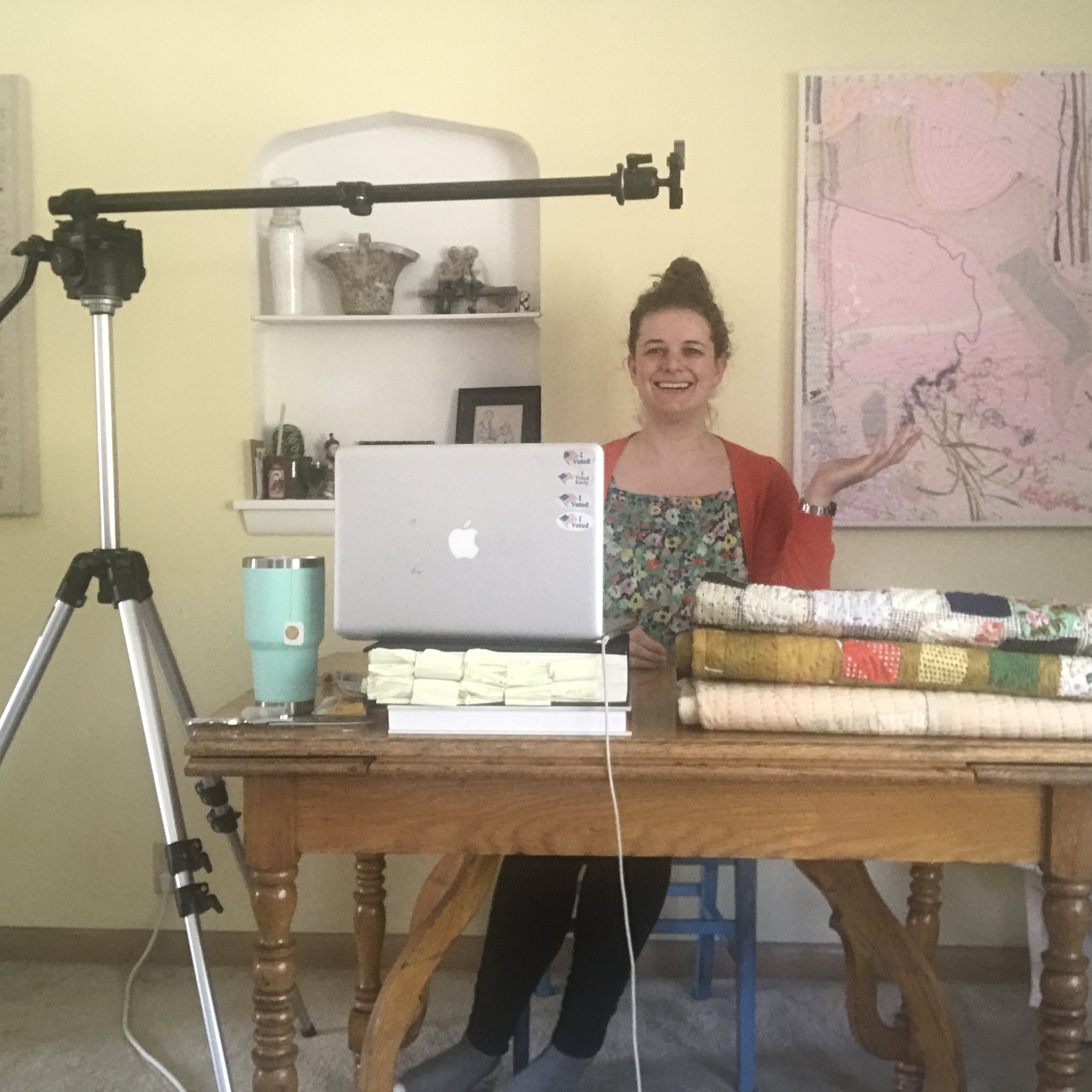My Favorite Supplies
Thanks for your interest in the tools that I work with. These are my genuine FAVORITES. I can share this information for free because of some generous affiliates.
Every time you purchase from my affiliate links you are supporting me and my artwork. ❤️
My Amazon Shop has categories highlighting my favorite quilting supplies, fabric, books, body care, photography equipment, and an entertaining list of miscellaneous items.
Snuggly Monkey, is a lovely independent shop that has a $5 off coupon from me, and they carry my favorite gripping thimbles, and many lovely threads.
Thimbles
My hands are my favorite tool, and my thimbles are an extension of them! I like to use a ‘pushing’ and ‘pulling’ thimble
To push, like a hammer:
The Clover Protect and Grip in small (my size), medium and large is great because it is soft and flexible, and allows for good circulation and blood flow in your finger. I prefer to wear it on my ring finger and I push from the tip of my finger. Other brands with silicon or leather thimbles would also be soft on your fingers. I do not recommend ‘hard’ thimbles made entirely from metal.
To pull, like a pliers:
The Little House Needle Gripper Silicone Thimble is available in small, medium (my size), and large (I wear this on my thumb sometimes). I prefer to buy it from Snuggly Monkey, and you can use this $5 off coupon from me. *the small is very small.
Pulling Thimbles
I’ve tried a bunch of gripping thimbles over the years, and I started by using bandaids…. These are all worth the $ to test out because they help protect your hands.
The Clover Flexible Rubber Thimble in a size medium, (pink on my thumb) is pretty good. They have other sizes too. My pinkie and ring finger here are money counting grippers from Office Depot. If they fit you well, you might like them, but I haven’t found one that really works for me. The green gripper from Bohin has a hole for your finger nail, but it doesn’t hold up as long as the Little House Gripper. There are a few additional thimbles on my Amazon Shop Page, and it’s good to test to find your favorite. My favorite is from Little House, linked above. I only wear grippers on one finger at a time.
Even better than a gripping disc is Dycem Non-slip. Order a roll, and then cut a small square to help pull your needle through- this is especially helpful when sewing with yarn for a tied quilt.
Thread
I prefer to sew with DMC pearl size 8. I usually buy it from the DMC website. It’s often possible to get it up to 20% off with an intro coupon and with their email blasts. I like it because it’s SO strong! Also, because it’s very visible, and I like that viewers can see my handwork. Plus, they have many great colors.
When I size up, it’s crochet cotton size 10 in Aunt Lydia’s or anything like it, depending on the color. It’s a 3-ply, so it looks less ‘ropey’ than a thicker pearl cotton.
When I size down, Sulky size 12 is lovely. I know that because they’ve sponsored handwork awards at QuiltCon, and I have a beautiful ‘book’ of their thread, which is very helpful for staying organized.
Additional Threads
I use sewing machine thread sometimes for handwork and with my hand-me-down Singer machine from the 70’s. I don’t have strong opinions on this thread, but do like to use 100% cotton.
Valdani pearl thread comes in beautiful colors, but sadly, it breaks on me a lot, so I rarely buy it now.
Wonderfil pearl #8 has gotten stronger recently, and if they have colors that you love, it could be worth the extra $ compared with DMC.
Superior Threads has some excellent new metallic threads, especially the “Glitter” line.
Needles
I like the Milliner’s Needles from Dritz because they pierce the fabric easily (some other milliners don’t), the eye is the same diameter as the length (gentler on my body to pull through), and the length works for me to stack a lot of stitches with each pull of the needle. I use sizes 7 and 9 in the pack the most frequently.
I’ve tried the Richard Hemming and Son size 9 milliners pack, and sadly, it’s much harder to push them into the fabric than the Dritz version.
The Clover Milliners multipack is also a good option.
For tied quilts, I like to use 3” Soft Sculpture Doll Needles from Dritz
Pins
I baste with safety pins, and find that these ‘regular’ saferty pins from Dritz get the job done easily.
I like straight pins for piecing, and I use Dritz yellow quilting straight pins.
I like applique pins when I’m using an embroidery hoop, and these Clover glass headed appliqué pins are great. (The all metal ones without the glass head are very challenging to pick up, push into fabric, and keep organized.)
Fabric
I prefer to sew with natural fibers and fabrics that can hold a crease. When in doubt, I like neutrals and natural hand dye, but you can see on my Gallery page that I use all kinds of fabrics. Cotton, silk, and linen are my favorites.
I generally don’t pre-wash my fabrics. I occasionally iron the wrinkles out before using them. 😉
The fabric that I already own, and unique prints that are purchased abroad or vintage are favorites of mine. I tend to stay away from the trendy new brands that are easily recognizable to most quilters.
feelgoodfibers.com is a wonderful resource for buying used.
I love shopping at the annual June rummage at the Wisconsin Museum of Quilts & Fiber Arts.
Additional Fabric 1
I like to buy unbleached cotton muslin in ‘wide yardage,’ at 90” or 120”. This is an Amazon example of what I used to look for it at JoAnn Fabrics and Fabric.com, and I would love to find a favorite resource for an organic version. I often use this wide fabric for backing or as a base for a wholecloth appliqué quilt like Meuse, Pandemic, Invisible, Sweetheart. I’ve recently found some colorful 59” cotton poplin on Amazon, that I used in So Many Small Things.
I like using transparent fabrics, and usually test looking at my hand throught them to see if they’ll work. Silk organza, cotton lawn, linen, and even polyester have all worked well for me- repurposing clothing and window curtains is a great place to start.
Additional Fabric 2
When mending, I like to use this 4-way stretch cotton jersey. (I’ve used it to make myself some leggings too!)
I love using repurposed textiles. I’ll often pre-wash them to ensure that they’re strong and clean.
I’m cautious with bedsheets as a high thread-count can be very taxing and my hands and wrists. Look for low thread-count, and test the fabric by sewing through two layers for a few inches. When repurposing sheets works, it’s great!!
Jacquard Cyanotype Pretreat Mural Fabric is fun for blue and white photographic silhouette images on fabric, like in this quilt
Scissors
These Westscott 2 for $10 scissors cut fabric better than the ‘fabric scissors’ that I’ve spent way more $ on. (In America, you can fly with scissors like this that are 4” or less!)
The ergonomic grip and easy safety lock on this Fiskars rotary is the BEST, and I’ve linked refill blades, a ruler, a cutting mat, and Pellon pattern drafting interfacing too.
For international travel airplane sewing, nothing beats a hand-shaped nail clippers.
This $5 off coupon code from Snuggly Monkey can connect you with this super cute ‘Small Storkette Embroidery Scissors’ in a variety of colors, and a ‘rabbit scissors.’
Marking Tools
Most of the time when I mark fabric, I lay out a line of thread, and create a dot-to-dot with straight pins, and that works great.
Occasionally, but especially when making framed quilts, sleeves to hang quilts on the wall, and when sewing a bojagi, I like to use the Clover Hera Marker to create a pressure based shiny mark on my fabric. No need to wash or iron it away.
The Sewline Air-Erasable Fabric Pen has worked well for me with quilt sleeves, text, and other embroidery sketching, but the mark rarely lasts longer than an hour, so sew quickly, or retrace frequently. If you can get your fabric wet after drawing, Crayola Ultra-Clean Washable Markers are another great way to make a temporary mark, except that I don’t trust the red ;)
*I don’t use Frixion pens, because I’ve heard too many scary stories about them.
Embroidery Hoops
I like using bamboo embroidery hoops. They’re great for embroidery and applique. I use a lot of both techniques on my quilts. The bamboo is smoother than other kinds of wood, but grips better than plastic- and feels nicer than plastic. I often use a 3”, 4”, 5”, 6”, and 9” hoop. I love that the tiny ones fit in my travel sewing kit. This is a nice multi-size multi-pack.
I appreciate oval hoops, because they can hold a larger space, while still being easy to reach fully inside the hoop
See me appliqué with a small hoop on YouTube.
See me embroider with a hoop on YouTube.
Batting
Warm and Natural king-sized cotton batting is my regular go-to, although I am curious about using flannel bedsheets and other re-purposed items from the thrift store… I like that there isn’t any glue in this, that it is grown in America, and that my needle glides through it effortlessly. I don’t fuss about which way is up, and I find that I can fuse two scraps together easily with a zigzag on my sewing machine to make the most of all of it.
I also like Toasty Cotton Batting, and enjoy that it’s slightly less expensive and thinner than Warm and Natural.
See me baste a quilt on YouTube.
Tension
You’ll need a weight to create tension when quilting. At home I use a 5lb book. When traveling, you could use your purse, a laptop computer, or another creative solution.
I also have some clever ways that I like to use my body to create tension, but these may not be accessible/comfortable for all bodies.
Binding Clips
Binding clips are a favorite tool of mine. I usually just use 3-5 of them at a time. They’re handy to keep in multiple places, and useful in the kitchen too, so this 100-pack in a cute rabbit tin is an affordable option.
Hand Yoga Tools
A marma stick is a wonderful tool to put in your sewing kit to use to care for your hands, I buy them from my friend and teacher, Indu Arora.
This YouTube video has a great intro to using a marma stick.
This is my second marma stick video on YouTube.
A gua sha is another wonderful too for breaking up tension in your hands and forearms.
This YouTube video has a gua sha demo.
A pencil, sock, and tennis ball are great hand yoga tools. Learn to use them in this video on YouTube.
See more options on the Body Care section of my Amazon Shop
Miscellaneous
Photography, lighting, framing, stapling, mat cutting, rulers, needle threading, sealing wood, books I’m in, books I’ve read, body wellness tools, fabric storage tools, and MORE are on my Amazon Shop page.
Some exciting things to look for in the Amazon Shop are…
My favorite fanny pack
My massage chair
My favorite snacks & supplements
















